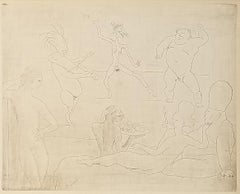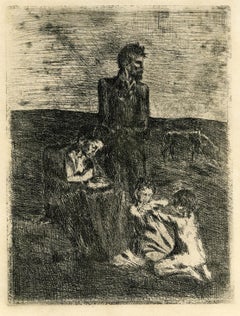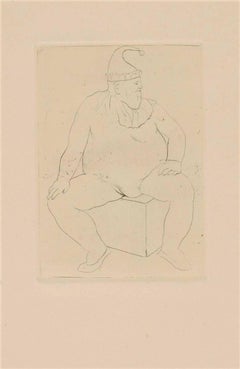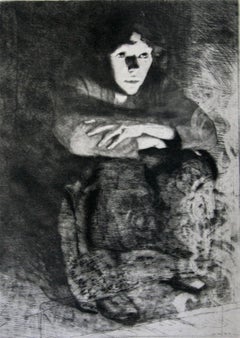Early 1900s Art
to
2
3
1
1
1
3
1
2
2
Overall Height
to
Overall Width
to
1
1
4
3
3
2
1
1
1
1
687
2
4
4
9
28
70
244
178
26
3
774
47
26
24
23
3
2
2
1
Period: Early 1900s
Artist: Pablo Picasso
"La Danse Barbare (from Les Saltimbanques), " Pablo Picasso, Figurative Print
Located in New York, NY
Pablo Picasso (1881 - 1973)
La Danse Barbare (from La Suite des Saltimbanques), 1905, printed 1913
Etching on Van Gelder Zonen wove paper
Sheet 13 x 20 inches
From the edition of 250...
Category
Modern Early 1900s Art
Materials
Paper, Etching
Les Pauvres (The Poor), from the famous Blue Period
Located in Fairlawn, OH
Les Pauvres (The Poor)
Created during the artist's famous "Blue Period"
Etching on Van Gelder Zonen paper, 1905
From: "La Suite de Saltimbanques" (Acrobats) [...
Category
French School Early 1900s Art
Materials
Etching
Pablo Picasso, Le Saltimbanque au Repos from La Suite des Saltimbanques
Located in Chatsworth, CA
An original drypoint by Pablo Picasso, originally done in 1905 and printed in 1913. From the early series of Picasso engravings, entitled "La Suite d...
Category
Impressionist Early 1900s Art
Materials
Drypoint
Nature Morte, Compotier - Etching and Drypoint by Pablo Picasso - 1909
Located in Roma, IT
Nature Morte, Compotier is a rare black and white drypoint on laid ivory-colored paper, realized by Pablo Picasso in 1909. Edition of 100.
Hand-signed in pencil on the lower right m...
Category
Cubist Early 1900s Art
Materials
Etching, Drypoint
Related Items
Corralled Horse (Artists Proof), 1940s Framed American Modernist Horse Etching
Located in Denver, CO
"Corralled Horse", is an etching on paper by western artist Ethel Magafan (1916-1993) of a single dark horse standing outside in a wooden fenced corral. Presented in a custom frame, outer dimensions measure 19 x 23 inches. Image size is 10 x 14 inches. This is marked as an Artist Proof
Piece is in very good condition - please contact us for a detailed condition report.
Provenance: Estate of Artist, Ethel Magafan
Expedited and international shipping is available - please contact us for a quote.
About the Artist:
Ethel Magafan
Born 1916
Died 1993
The daughter of a Greek immigrant father and a Polish immigrant mother who met and married in Chicago, Ethel Magafan, her identical twin sister Jenne and their elder sister Sophie grew up in Colorado to which their father relocated the family in 1919. They initially lived in Colorado Springs where he worked as a waiter at the Antlers Hotel before moving to Denver in 1930 to be head waiter at the Albany Hotel. Two years later during the Great Depression Ethel and Jenne experienced at sixteen the tragic loss of their father who had encouraged their artistic aspirations.
He was proud when Ethel, a student at Morey Junior High School, won top prizes in student poster contests sponsored by the Denver Chamber of Commerce and the Denver Post. At East High School in Denver she and Jenne contributed their art talents to the school’s and by their senior year were co-art editors of the Angelus, the 1933 yearbook. At East they studied art with Helen Perry, herself a student of André Lhote in Paris and the Art Institute of Chicago. Her decision to abandon an arts career to teach high school students served as an important example to Ethel and Jenne, who early on had decided to become artists. In a city-wide Denver competition for high school art students Ethel won an eighteenweek art course in 1932-33 to study at the Kirkland School of Art which artist Vance Kirkland had recently established in the Mile High City.
Perry encouraged the Magafan twins’ talent, exposing them to the work of Matisse, Picasso and Cézanne and introducing them to local artists and architects like Frank Mechau and Jacques Benedict whom she invited to speak in her high school art classes. She paid the modest tuition for Ethel and Jenne to study composition, color, mural designing and painting at Mechau’s School of Art in downtown Denver in 1933-34. In the summer of 1934 and for a time in 1936 they apprenticed with him at his studio in Redstone, Colorado.
When they returned to Denver in 1934 with no family breadwinner to support them, their mother insisted that they have real jobs so they worked as fashion artists in a Denver department store. When Jenne won the Carter Memorial Art Scholarship ($90.00) two years later, she shared it with Ethel so that both of them could enroll in the Broadmoor Art Academy (now the Colorado Springs Fine Arts Center) where they studied with Mechau. When the scholarship money ran out after two months, he hired them as his assistants. Along with Edward (Eduardo) Chavez and Polly Duncan, they helped him with his federal government mural commissions. At the Fine Arts Center Ethel also studied with Boardman Robinson and Peppino Mangravite, who hired her and Jenne in 1939 to assist him in his New York studio with two murals commissioned for the post office in Atlantic City, New Jersey. Like their Denver high school art teacher, Robinson also stressed the need to draw from nature in order to "feel" the mountains, which later become the dominant subject matter of Ethel’s mature work after World War II.
Mechau trained her and her sister in the complex process of mural painting while they studied at the Colorado Springs Fine Arts Center, teaching them the compositional techniques of the European Renaissance masters. This also involved library research for historical accuracy, small scale drawing, and Page 2 of 4 the hand-making of paints and other supplies. Ethel recalled that their teacher "was a lovely man but he was a hard worker. He drove us. There was no fooling around."
Her apprenticeship with Mechau prepared her to win four national government competitions, beginning at age twenty-two, for large murals in U.S. post offices: Threshing – Auburn, Nebraska (1938), Cotton Pickers – Wynne, Arkansas (1940), Prairie Fire – Madill, Oklahoma (1940), and The Horse Corral – South Denver, Colorado (1942). In preparation for their commissions Ethel and her sister made trips around the country to pending mural locations, driving their beat-up station wagon, dressed in jeans and cowboy boots with art supplies and dogs in tow. She and Jenne combined their talents in the mural, Mountains in Snow, for the Department of Health and Human Services Building in Washington, DC (1942). A year later Ethel executed her own mural, Andrew Jackson at the Battle of New Orleans, January 8, 1814, for the Recorder of Deeds Building, also in Washington, DC. Her first mural commission, Indian Dance, done in 1937 under the Treasury Department Art Project for the Senate Chamber in the United States Capitol, has since disappeared.
Ethel and her sister lived and worked in Colorado Springs until 1941 when their residence became determined by the wartime military postings of Jenne’s husband, Edward Chavez. They moved briefly to Los Angeles (1941-42) and then to Cheyenne, Wyoming, while he was stationed at Fort Warren, and then back to Los Angeles for two years in 1943. While in California, Ethel and Jenne executed a floral mural for the Sun Room of the Beverly Hills Hotel and also painted scenes of the ocean which they exhibited at the Raymond and Raymond Galleries in Beverly Hills. While in Los Angeles they met novelist Irving Stone, author of Lust for Life, who told them about Woodstock, as did artists Arnold Blanch and Doris Lee (both of whom previously taught at the Colorado Springs Fine Arts Center school. In summer of 1945 Ethel, her sister and brother-in-law drove their station wagon across the country to Woodstock which became their permanent home.
A year later Ethel married artist and musician, Bruce Currie, whom she met in Woodstock. In 1948 with the help of the GI Bill they purchased an old barn there that also housed their individual studios located at opposite ends of the house. The spatial arrangement mirrors the advice she gave her daughter, Jenne, also an artist: "Make sure you end up with a man who respects your work…The worst thing for an artist is to be in competition with her husband."
In 1951 Ethel won a Fulbright Scholarship to Greece where she and her husband spent 1951-52. In addition to extensively traveling, sketching and painting the local landscape, she reconnected with her late father’s family in the area of Messinia on the Peloponnese peninsula in southern Greece. At the same time, her sister Jenne accompanied Chavez on his Fulbright Scholarship to Italy where they spent a productive year painting and visiting museums. Shortly after returning home, Jenne’s career was cut tragically short when she died of a cerebral hemorrhage at age thirty-six. It deeply affected Ethel whose own work took on a somber quality for several years conveyed by a darkish palette, as seen in her tempera painting, Aftermath (circa 1952).
In the 1940s Ethel and her sister successfully made the important transition from government patronage to careers as independent artists. Ethel became distinguished for her modernist landscapes. Even though Ethel became a permanent Woodstock resident after World War II, from her childhood in Colorado she retained her love of the Rocky Mountains, her "earliest source of my lifelong passion for mountain landscape." She and her husband began returning to Colorado for annual summer camping trips on which they later were joined by their daughter, Jenne.
Ethel did many sketches and drawings of places she found which had special meaning for her. They enabled her to recall their vital qualities which she later painted in her Woodstock studio, conveying her feeling about places remembered. She also produced a number of watercolors and prints of the Colorado landscape that constituted a departure from the American Scene style of her earlier paintings. Her postwar creative output collectively belongs to the category of landscape abstractionists as described by author Sheldon Cheney, although to a greater or lesser degree her work references Colorado’s mountainous terrain. She introduced a palette of stronger pastels in her paintings such as two temperas, Evening Mountains from the 1950s and Springtime in the Mountains from the early 1960s.
In 1968 she was elected an Academician by the National Academy of Design in New York. Two years later, based on results of her many summer trips to Colorado, the U.S. Department of the Interior invited her to make on-the-spot sketches of the western United States, helping to document the water resources development and conservation efforts by the Department of the Interior. Her sketches were exhibited at the National Gallery in Washington, DC, and then sent on a national tour by the Smithsonian Institution. Similarly, her previous work as a muralist earned her a final commission at age sixty-three for a 12 by 20 foot Civil War image, Grant in the Wilderness, installed in 1979 in the Chancellorsville Visitors Center at the Fredericksburg National Military Park in Virginia. In the 1970s, too, she taught as Artist-in-Residence at Syracuse University and at the University of Georgia in Athens.
Her many awards include, among others, the Stacey Scholarship (1947); Tiffany Fellowship (1949); Fulbright Grant (1951-52, in Greece with her husband); Tiffany Fellowship (1949); Benjamin Altman Landscape Prize, National Academy of Design (1955); Medal of Honor, Audubon, Artists (1962); Henry Ward Granger Fund Purchase Award, National Academy of Design (1964); Childe Hassam Fund Purchase Award, American Academy of Arts and Letters (1970); Silver Medal, Audubon Artists (1983); Champion International Corporation Award, Silvermine Guild, New Canaan, Connecticut (1984); John Taylor Award, Woodstock Artists Association, Woodstock, New York (1985); Harrison Cady...
Category
American Modern Early 1900s Art
Materials
Etching, Paper
Dans les Cendres (In the embers)
Located in Storrs, CT
Dans les Cendres (In the embers). 1887. Delteil catalog 67 state iii. State after the plate was cut down and a second figure eliminated (the two earlier states are of the greatest rarity). Etching, drypoint and roulette. 16 3/4 x 12 1/8 (sheet 19 1/2 x 14). Edition 50. Illustrated: Print Collector's Quarterly 9 (1921): 254. A very rich impression with plate tone and drypoint burr, printed on simili-japon. Provenance: Frederick Keppel & Co. This is one of the artist's most striking images. Signed in pencil. Housed in 25 x 20-inch archival mat, suitable for framing.
Paul Albert Besnard, was an impressionist painter. In 1866, the seventeen-year-old son of artist parents began his studies at the École des Beaux-Arts Paris. In 1874, Besnard won the important Prix de Rome, with which the academy distinguished young talent. A portion of the scholarship is a stay of several years in Rome. Besnard married Charlotte Dubray, a sculptress, during this time in Rome. The couple lived in England, where Besnard exhibited at the Royal Academy London, between 1881 and 1884. He became involved with English portrait painting during this period, which had a lasting influence on his work.
In the years that followed, Besnard broke with the academic tradition. In 1886, he presented the portrait of Madame Roger Jourdain...
Category
Impressionist Early 1900s Art
Materials
Drypoint, Etching
Jean Francois Millet, "La Boullie (The Porridge)", Drypoint Etching, 1861
Located in Long Island City, NY
Etching printed in brownish black on light tan Chine collé, 1861. Image measures 6 x 5 inches, displayed in a 15.5 x 12.5 inch frame. Etched signature and date lower left. A very goo...
Category
Impressionist Early 1900s Art
Materials
Drypoint, Etching, Intaglio
NATURE MORTE AU CITRON ET A LA CRUCHE
Located in Aventura, FL
Selected from the personal collection inherited by Marina Picasso, Pablo Picasso's granddaughter. After Pablo Picasso's death, his granddaughter Marina authorized the printing of t...
Category
Cubist Early 1900s Art
Materials
Paper, Lithograph
Pablo Picasso (after) Helene Chez Archimede - Wood Engraving
Located in Collonge Bellerive, Geneve, CH
Pablo Picasso (after)
Helene Chez Archimede
Medium: engraved on wood by Georges Aubert
Dimensions: 44 x 33 cm
Portfolio: Helen Chez Archimede
Year: 1955
Edition: 240 (Here it is on...
Category
Cubist Early 1900s Art
Materials
Engraving
H 17.33 in W 13 in D 0.04 in
Tool Drypoint: Paintbrush by Jim Dine, black and white tool still life sketch
By Jim Dine
Located in New York, NY
Jim Dine drew the plate for this image in the same period as his “Thirty Bones of My Body” 1972 portfolio of drypoint tool images. Crisbrook paper (30 x 22 in. / 76.2 x 56 cm.) and p...
Category
Modern Early 1900s Art
Materials
Drypoint
Célestine, Young Girl and Client, 1968 (347 Series, B.1588)
Located in Greenwich, CT
"Celestine, Young Girl and Client," 1968 is an aquatint from Picasso's 347 Series. The image size is 3.5 x 5 inches and the framed size is 18.25 x 19.5 inches. Signed 'Picasso' lower...
Category
Modern Early 1900s Art
Materials
Aquatint, Paper
TETE DE MORTE, LAMPE CRUCHES ET POIREAUX
Located in Aventura, FL
Selected from the personal collection inherited by Marina Picasso, Pablo Picasso's granddaughter. After Pablo Picasso's death, his granddaughter Marina authorized the printing of t...
Category
Cubist Early 1900s Art
Materials
Lithograph, Paper
Madame Helleu Looking at Watteau drawings at the Louvre..
Located in Storrs, CT
Madame Helleu Looking at Watteau drawings at the Louvre. (En regardant les Watteau de Louvre). c. 1895. Drypoint printed in 2 colors - black and sepia. 11 3/4 x 15 7/8. Goncourt 3, d...
Category
Impressionist Early 1900s Art
Materials
Drypoint, Color
H 20 in W 14.5 in D 2 in
Resurrection (aka Flying Figures; Border of the Lake)
Located in New York, NY
Arthur B. Davies (1862-1928), Resurrection (aka Flying Figures; Border of the Lake), drypoint and aquatint on zinc, 1916, signed with the estate stamp lower right. Reference: Price 2...
Category
American Impressionist Early 1900s Art
Materials
Drypoint, Aquatint
A 19th century Colored Botanical Engraving of Flowers by Czeiger
Located in Alamo, CA
A colored 19th century botanical engraving of flowers by Anstalt S. Czeiger of Vienna, Austria. An inscription at the bottom includes: "Wien, Kai...
Category
Academic Early 1900s Art
Materials
Engraving
H 27.75 in W 21.25 in D 0.75 in
Hand-colored 1834 Joseph Paxton Botanical Engraving of Yellow Trumpet Flowers
By Joseph Paxton
Located in Alamo, CA
A hand-colored engraving of yellow trumpet flowers from Sir Joseph Paxton's (1803-1865) "Magazine of Botany and Register of Flowering Plants", published in 1834. This engraving entit...
Category
Academic Early 1900s Art
Materials
Engraving
H 19.25 in W 16.75 in D 0.63 in
Previously Available Items
Tête de Femme (Madeleine)
Located in New York, NY
A very good, dark and richly-inked impression of this early etching with strong contrasts. Edition of 250. Printed by Louis Fort, Paris. Published by Vollard, Paris. From "Saltimbanq...
Category
Modern Early 1900s Art
Materials
Etching
Salomé from La Suite des Saltimbanques, Etching by Pablo Picasso 1905
Located in Long Island City, NY
Artist: Pablo Picasso
Title: Salomé from La Suite des Saltimbanques
Year: 1905
Medium: Drypoint Etching on van Gelder wover paper, signed and dated in the plate
Size: 25.75 in. x 19...
Category
Modern Early 1900s Art
Materials
Etching
"Poupée"
Located in Berlin, DE
Skulpture conceived in 1907 by Pablo Picasso ( 1881-1973 ).
Bronze with dark patina on marble base. Cast from 1964. Edition of 12 exemplare.
Foundry mark incised on the leg: E.GODA...
Category
Early 1900s Art
Materials
Bronze






